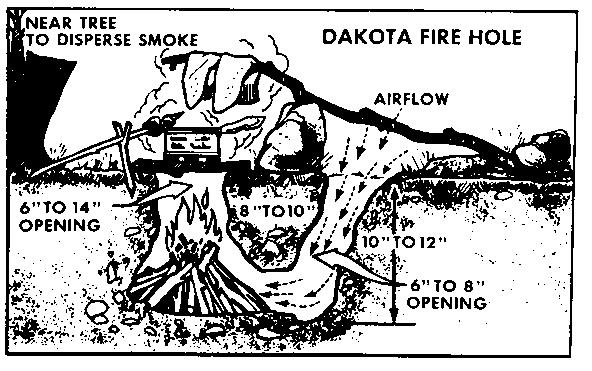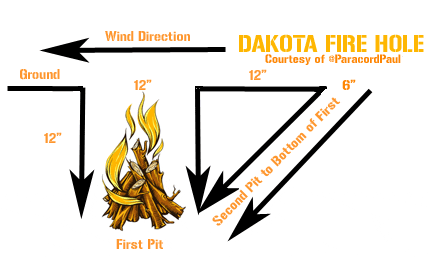Family Preparedness: Fire in the Hole!
Family preparedness should include learning new skills that will be helpful should the need arise. These skills should be practiced enough times so that there is no floundering around when it’s time that you actually need to put them to use in an emergency.
If you watch any of the survival shows on T.V., knowing out to build a fire is at the top of the list! One skill that should be in everyone’s skill set is how to build a Dakota fire hole.

The advantages of a Dakota fire hole over a traditional fire are many.

Digging the Dakota hole is easy. Simply dig a hole about a foot in diameter and a foot deep. This is the fire pit. Dig a second hole about 6 to 8 inches away. This hole will be dug on an angle and end at the bottom of the first hole. This second hole is the air vent that will feed oxygen to your fire. If possible, situate the vent hole so that the wind will blow from the vent into the fire pit. You will get a much hotter, faster-burning fire that way. Build your fire in the larger hole.
The Dakota fire hole is perfect for cooking. You can create a good cooking surface by laying a few green branches across the hole to make a surface to set a pot. You can also set a rock over a portion of the hole and cook directly on the rock if necessary.
While this type of fire is not great for warmth, you can take advantage of it to heat your body. When you’re finished cooking, warm a few rocks in the coals and add them to your sleeping bag or simply in your sleeping area. Rocks are great for storing thermal mass and releasing it slowly through the night. You can also add rocks to the coals, cover up the holes with the soil that you dug out and sleep directly over the covered pit. The rocks and soil are both good at storing heat and will keep the ground under you warmer through the night.
When you are ready to move on, fill the hole with the original soil and sod or covering that you found on it, and it is nearly impossible to detect that anyone was ever there.
If an emergency situation should arise in cold weather, warm food and liquids in your belly and a warmer place to sleep could make a very big difference in survival. A Dakota-hole fire pit is a nifty thing to know about and makes both things possible!
